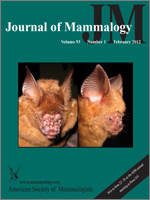Aquatic foraging is a fundamental component of the behavior of a number of small mammals, yet comprehensive observations of diving are often difficult to obtain under natural circumstances. Semiaquatic mammals, having evolved to exploit prey in both aquatic and terrestrial environments, are generally not as well adapted for diving (or for life in the water) as are fully aquatic species. Because dive ability also tends to increase with body size, small, semiaquatic mammals are presumed to have fairly limited dive ability. Nevertheless, diving plays an important role in food acquisition for many such species. We used time–depth recorders (TDRs) to measure and describe the dive performance of 9 female and 5 male free-living American mink (Neovison vison; body mass approximately 1 kg) on lowland rivers in the southern United Kingdom. We recorded dives up to 2.96 m deep (maximum depth X¯ = 1.82 m) and up to 57.9 s in duration (maximum duration X¯ = 37.2 s). Dive duration was approximately 40% of that predicted by allometry for all air-breathing diving vertebrates (as might be expected for a small, semiaquatic animal) but was twice as long as previously measured for mink in captivity. Mink performed up to 189 dives per day (X¯ = 35.7 dives/day), mostly during daylight, and spent a maximum of 38.4 minutes diving per day (X¯ = 7.6 min/day). Some individuals maintained particularly high diving rates over the coldest months, suggesting that the benefits of aquatic foraging in winter outweigh the costs of heat loss. We observed a number of very shallow dives (depth approximately 0.3 m) of particularly long duration (up to 30 s). The function of these dives is currently unknown, but possibilities include searching for prey, travelling, or avoidance of threats. There is only 1 other study of which we are aware that presents detailed measurements of dive performance in a small, shallow-diving, semiaquatic mammal.
How to translate text using browser tools
1 February 2012
Dive performance in a small-bodied, semi-aquatic mammal in the wild
Lauren A. Harrington,
Graeme C. Hays,
Laura Fasola,
Andrew L. Harrington,
David Righton,
David W. Macdonald
ACCESS THE FULL ARTICLE

Journal of Mammalogy
Vol. 93 • No. 1
February 2012
Vol. 93 • No. 1
February 2012
aquatic foraging
data logger
mink
mustelid
Neovison
TDR
time–depth recorder




